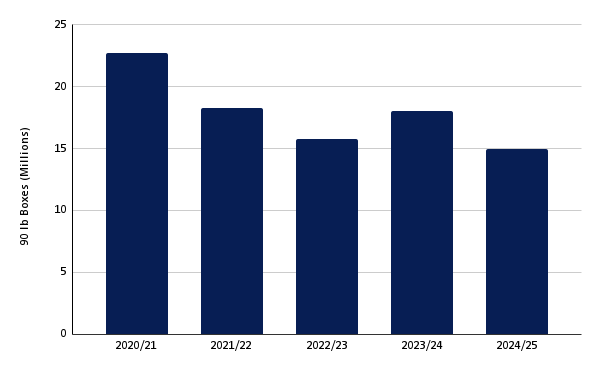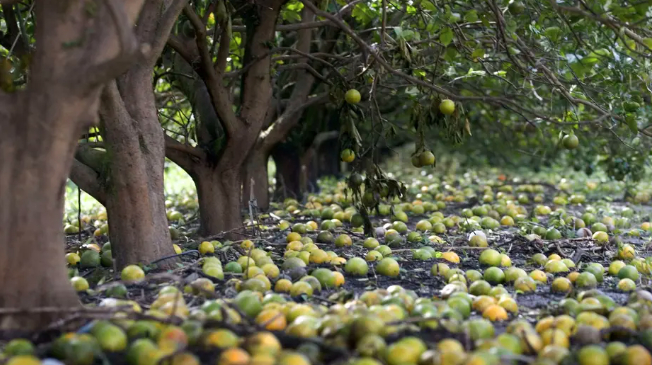Florida’s 2024–25 Orange Season Sees 16% Drop Amid Hurricane Milton's Damage

Orange production in the United States (US) continues to be impacted by disease and adverse weather conditions. The USDA's initial forecast for Florida's 2024–25 citrus season, released on October 11, shows a grim outlook for orange production. This outlook is compounded by expected damages from Hurricane Milton, which will be reflected in the December 10 update.
Florida's total orange production is forecast at 15 million boxes, a 16% decrease from the previous season. Non-Valencia oranges are forecasted at 6 million boxes, marking an 11% decrease, while Valencia oranges are estimated at 9 million boxes, representing a sharp 20% decline compared to last season. Navel oranges are projected at 190,000 boxes, making up about 3% of the non-Valencia total and showing a 6% increase over last year's crop.
Figure 1. Florida’s Total Orange Production

Key production metrics indicate underlying challenges in the sector. The number of bearing trees has fallen, with non-Valencia trees decreasing by 17% and Valencia trees by 11%. For non-Valencia oranges, the estimated fruit per tree has risen to 392 pieces, an improvement over last season, but fruit size is still below the minimum threshold, requiring 344 pieces to fill a standard 90-pound (lb) box. For Valencia oranges, fruit per tree has decreased significantly to 244 pieces, the lowest since the 1964–65 season, with an estimated 266 pieces required to fill a 90-lb box. Projected fruit drop rates are concerning, with 31% for non-Valencia and 38% for Valencia.
Impact of Hurricane Milton
Before Hurricane Milton's landfall in Oct-24, there was growing optimism in Florida's citrus industry after years of battling citrus greening (Huanglongbing or HLB disease) and recovering from the devastating effects of Hurricane Ian in 2022. Growers had been hopeful for a productive season, thanks to visible improvements in tree health and bloom due to targeted treatments.
However, Hurricane Milton severely impacted key citrus-producing areas. High winds caused widespread fruit and leaf drop, with damage particularly severe in early varieties. HLB-affected trees, already weakened by disease, are highly susceptible to further stress from abiotic factors like hurricanes. As a result, even trees that initially retained fruit after the storm are likely to experience continued fruit loss in the days following.
Figure 2. Impact of the Hurricane on a Farm in Florida

Measures for Recovery and Mitigation
The Florida citrus industry is now focusing on strategies to minimize further losses and rehabilitate damaged trees. Key recovery efforts include:
- Chemical Treatments for Fruit Retention: The University of Florida Institute of Food and Agricultural Sciences (UF/IFAS) recommends growers apply 2,4-D and gibberellic acid (GA) to promote fruit retention and boost canopy recovery. GA has been particularly effective in trials, improving fruit retention even in trees impacted by hurricanes. In field trials between 2021 and 2023, GA-treated Hamlin orange trees in Polk and Hardee counties retained 50 pounds more fruit than untreated control trees, even after Hurricane Ian devastated the region in 2022.
- Financial Assistance: The Florida Department of Agriculture and Consumer Services (FDACS) has announced that low-interest or interest-free loans of up to $500,000 are available for farmers, ranchers, and growers affected by Hurricane Milton. This financial aid is expected to help cover immediate recovery needs and support long-term revitalization efforts in the citrus sector.
Outlook and Long-Term Concerns
The current forecast does not fully capture the extent of the damage from Hurricane Milton, and the December update is expected to provide a more accurate assessment. In the meantime, the 16% drop in total orange production already indicates the pressures the Florida citrus industry faces. Beyond weather-related damage, the ongoing battle with citrus greening remains a significant hurdle.
Looking ahead, the industry’s recovery will depend heavily on mitigating further stress on trees, implementing effective therapies, and securing the necessary financial support to weather this challenging period. As more growers adopt GA treatments and leverage financial aid, there is hope that Florida’s citrus groves can stabilize and begin to recover. However, with ongoing threats from climate extremes and disease, the future remains uncertain.





